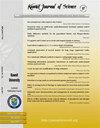Biogenic synthesis and characterization of MgO/CuO nanohybrids for degradation of acid blue 113 dye: A sustainable environmental remedial approach
IF 1.1
4区 综合性期刊
Q3 MULTIDISCIPLINARY SCIENCES
引用次数: 0
Abstract
This work focused on the green synthesis of MgO and CuO nanoparticles using the ripened fruit extract of Prunus armeniaca (apricot) using a green, economical, eco-friendly method. The fruit extract acts as a reducing and capping agent and does not require external reducing and stabilizing agents. The formation of nanoparticles was checked by UV–Visible spectrophotometer. Different techniques including UV–Visible, X-ray diffraction (XRD), Fourier-transform infrared spectroscopy (FTIR), scanning electron microscopy (SEM), nanoparticle tracking analysis (NTA), and zeta potential were used to characterize the green-synthesized nanoparticles. The nano-scaled MgO and CuO particles were used to decolorize Acid Blue 113 (AB113). Dye removal efficiency of MgO/CuO nanohybrid was determined by optimizing the reaction variables including dye level, nanoparticle mass, temperature, and pH. The maximum dye removal was observed at 10 mg/L dye level, 3:6 mg/L MgO/CuO nanohybrid (0.003/0.006 g/L), at 50 °C and 7 pH. The adsorptive and catalytic behavior of CuO/MgO nanohybrid showed promising results in the removal of the target dye. The kinetic study showed second order kinetics of the reaction. These hybrid nanoparticles could be employed to treat other harmful synthetic dyes to control water pollution.

MgO/CuO纳米杂化物降解酸性蓝113染料的生物合成与表征:一种可持续的环境修复方法
本文研究了以杏果实提取物为原料,采用绿色、经济、环保的方法合成氧化镁纳米粒子和氧化铜纳米粒子。果实提取物作为还原剂和封盖剂,不需要外部还原剂和稳定剂。用紫外可见分光光度计检测纳米颗粒的形成。采用紫外可见、x射线衍射(XRD)、傅里叶变换红外光谱(FTIR)、扫描电子显微镜(SEM)、纳米颗粒跟踪分析(NTA)和zeta电位等技术对绿色合成的纳米颗粒进行了表征。采用纳米氧化镁和氧化铜对酸性蓝113 (AB113)进行脱色。通过优化染料浓度、纳米颗粒质量、温度和ph对MgO/CuO纳米杂化物的去除率进行了研究。在10 mg/L染料浓度、3∶6 mg/L MgO/CuO纳米杂化物(0.003/0.006 g/L)、50℃和7 ph条件下,MgO/CuO纳米杂化物的去除率最高,CuO/MgO纳米杂化物对目标染料的吸附和催化性能显示出良好的效果。动力学研究表明反应为二级动力学。这些杂化纳米颗粒可用于处理其他有害的合成染料,从而控制水污染。
本文章由计算机程序翻译,如有差异,请以英文原文为准。
求助全文
约1分钟内获得全文
求助全文
来源期刊

Kuwait Journal of Science
MULTIDISCIPLINARY SCIENCES-
CiteScore
1.60
自引率
28.60%
发文量
132
期刊介绍:
Kuwait Journal of Science (KJS) is indexed and abstracted by major publishing houses such as Chemical Abstract, Science Citation Index, Current contents, Mathematics Abstract, Micribiological Abstracts etc. KJS publishes peer-review articles in various fields of Science including Mathematics, Computer Science, Physics, Statistics, Biology, Chemistry and Earth & Environmental Sciences. In addition, it also aims to bring the results of scientific research carried out under a variety of intellectual traditions and organizations to the attention of specialized scholarly readership. As such, the publisher expects the submission of original manuscripts which contain analysis and solutions about important theoretical, empirical and normative issues.
 求助内容:
求助内容: 应助结果提醒方式:
应助结果提醒方式:


